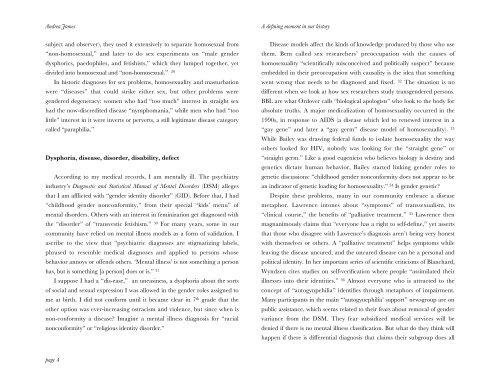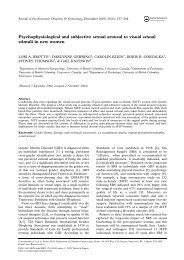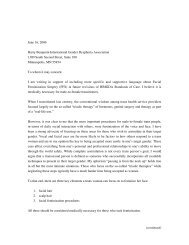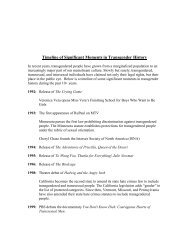A defining moment in our history - Transsexual Road Map
A defining moment in our history - Transsexual Road Map
A defining moment in our history - Transsexual Road Map
You also want an ePaper? Increase the reach of your titles
YUMPU automatically turns print PDFs into web optimized ePapers that Google loves.
Andrea JamesA <strong>def<strong>in</strong><strong>in</strong>g</strong> <strong>moment</strong> <strong>in</strong> <strong>our</strong> <strong>history</strong>subject and observer), they used it extensively to separate homosexual from“non-homosexual,” and later to do sex experiments on “male genderdysphorics, paedophiles, and fetishists,” which they lumped together, yetdivided <strong>in</strong>to homosexual and “non-homosexual.” 29In historic diagnoses for sex problems, homosexuality and masturbationwere “diseases” that could strike either sex, but other problems weregendered degeneracy: women who had “too much” <strong>in</strong>terest <strong>in</strong> straight sexhad the now-discredited disease “nymphomania,” while men who had “toolittle” <strong>in</strong>terest <strong>in</strong> it were <strong>in</strong>verts or perverts, a still legitimate disease categorycalled “paraphilia.”Dysphoria, disease, disorder, disability, defectAccord<strong>in</strong>g to my medical records, I am mentally ill. The psychiatry<strong>in</strong>dustry’s Diagnostic and Statistical Manual of Mental Disorders (DSM) allegesthat I am afflicted with “gender identity disorder” (GID). Before that, I had“childhood gender nonconformity,” from their special “kids’ menu” ofmental disorders. Others with an <strong>in</strong>terest <strong>in</strong> fem<strong>in</strong>ization get diagnosed withthe “disorder” of “transvestic fetishism.” 30 For many years, some <strong>in</strong> <strong>our</strong>community have relied on mental illness models as a form of validation. Iascribe to the view that “psychiatric diagnoses are stigmatiz<strong>in</strong>g labels,phrased to resemble medical diagnoses and applied to persons whosebehavior annoys or offends others. ‘Mental illness’ is not someth<strong>in</strong>g a personhas, but is someth<strong>in</strong>g [a person] does or is.” 31I suppose I had a “dis-ease,” an uneas<strong>in</strong>ess, a dysphoria about the sortsof social and sexual expression I was allowed <strong>in</strong> the gender roles assigned tome at birth. I did not conform until it became clear <strong>in</strong> 7 th grade that theother option was ever-<strong>in</strong>creas<strong>in</strong>g ostracism and violence, but s<strong>in</strong>ce when isnon-conformity a disease? Imag<strong>in</strong>e a mental illness diagnosis for “racialnonconformity” or “religious identity disorder.”Disease models affect the k<strong>in</strong>ds of knowledge produced by those who usethem. Bem called sex researchers’ preoccupation with the causes ofhomosexuality “scientifically misconceived and politically suspect” becauseembedded <strong>in</strong> their preoccupation with causality is the idea that someth<strong>in</strong>gwent wrong that needs to be diagnosed and fixed. 32 The situation is nodifferent when we look at how sex researchers study transgendered persons.BBL are what Ordover calls “biological apologists” who look to the body forabsolute truths. A major medicalization of homosexuality occurred <strong>in</strong> the1990s, <strong>in</strong> response to AIDS (a disease which led to renewed <strong>in</strong>terest <strong>in</strong> a“gay gene” and later a “gay germ” disease model of homosexuality). 33While Bailey was draw<strong>in</strong>g federal funds to isolate homosexuality the wayothers looked for HIV, nobody was look<strong>in</strong>g for the “straight gene” or“straight germ.” Like a good eugenicist who believes biology is dest<strong>in</strong>y andgenetics dictate human behavior, Bailey started l<strong>in</strong>k<strong>in</strong>g gender roles togenetic discussions: “childhood gender nonconformity does not appear to bean <strong>in</strong>dicator of genetic load<strong>in</strong>g for homosexuality.” 34 Is gender genetic?Despite these problems, many <strong>in</strong> <strong>our</strong> community embrace a diseasemetaphor. Lawrence <strong>in</strong>tones about “symptoms” of transsexualism, its“cl<strong>in</strong>ical c<strong>our</strong>se,” the benefits of “palliative treatment.” 35 Lawrence thenmagnanimously claims that “everyone has a right to self-def<strong>in</strong>e,” yet assertsthat those who disagree with Lawrence’s diagnosis aren’t be<strong>in</strong>g very honestwith themselves or others. A “palliative treatment” helps symptoms whileleav<strong>in</strong>g the disease uncured, and the uncured disease can be a personal andpolitical identity. In her important series of scientific criticisms of Blanchard,Wyndzen cites studies on self-verification where people “assimilated theirillnesses <strong>in</strong>to their identities.” 36 Almost everyone who is attracted to theconcept of “autogynpehilia” identifies through metaphors of impairment.Many participants <strong>in</strong> the ma<strong>in</strong> “‘autogynephilia’ support” newsgroup are onpublic assistance, which seems related to their fears about removal of gendervariance from the DSM. They fear subsidized medical services will bedenied if there is no mental illness classification. But what do they th<strong>in</strong>k willhappen if there is differential diagnosis that claims their subgroup does allpage 4









